new posts in all blogs
Viewing: Blog Posts Tagged with: earth day, Most Recent at Top [Help]
Results 26 - 50 of 106
How to use this Page
You are viewing the most recent posts tagged with the words: earth day in the JacketFlap blog reader. What is a tag? Think of a tag as a keyword or category label. Tags can both help you find posts on JacketFlap.com as well as provide an easy way for you to "remember" and classify posts for later recall. Try adding a tag yourself by clicking "Add a tag" below a post's header. Scroll down through the list of Recent Posts in the left column and click on a post title that sounds interesting. You can view all posts from a specific blog by clicking the Blog name in the right column, or you can click a 'More Posts from this Blog' link in any individual post.

How would YOU save our planet?With Earth Day fresh in our brains, we thought it was the perfect time to feature a question posted by AquaCat586.
“If you could do one thing to help the planet or humankind as a whole, what would it be? Or if you could invent one thing that would forward the advancement of human civilization, what would it be?”
It could be something real, or something you dream up, something small, or something on a large scale. The sky is the limit! What would you do to help the planet or advance civilization? Let us know in the Comments below!
To talk about more ways to save the earth, go to the Save the Planet Message Board
and meet lots of environmental crusaders.
— Ratha, Stacks Writer
This is a newsy post for May:
Celebrating Earth Day

Authors for Earth Day.
This week, I did a couple school visits to celebrate Earth Day, as part of the
Authors For Earth Day program. Yes, it was after Earth Day, but it was the only time we could schedule it.
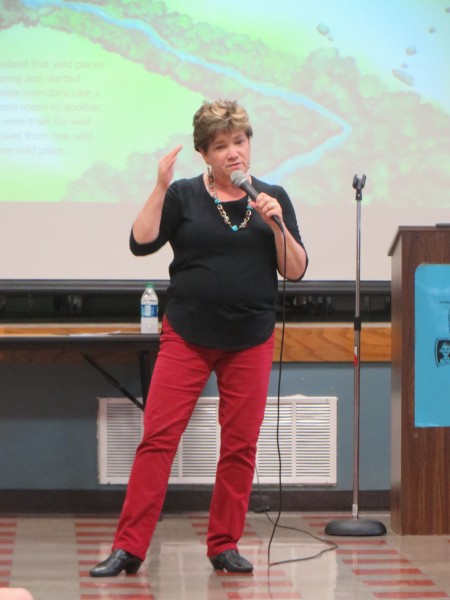
Darcy Pattison presenting at Gibbs Magnet Elementary School, Little Rock School District, as part of her participation in Authors For Earth Day.
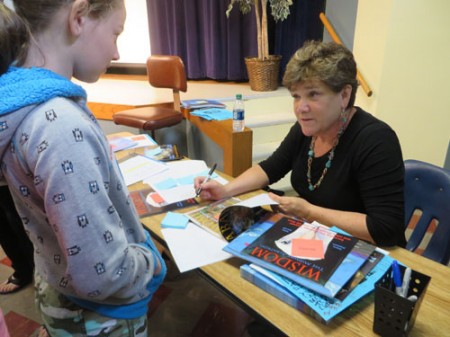
Darcy Pattison signing books at Authors For Earth Day event.
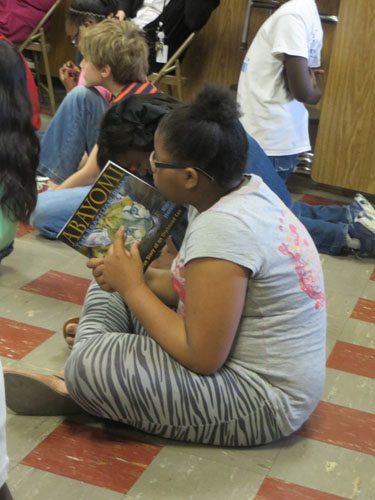
Student at Gibbs Elementary holding my book, ABAYOMI.
Fiction Notes: Featured SCBWI Blog for May/June
I’ve been notified that Fiction Notes will be one of the featured blogs on the SCBWI home page for the next two months. They choose about nine blogs to highlight and rotate them six times a year. I am surprised, but pleased to be included. I was the Arkansas SCBWI Regional Advisor for six years and Conference Director for 10–it’s an organization that has meant a lot to me.
Mother’s Day
Are you active on Pinterest? Here’s a new possibility for promoting your content. Pinterest has announced a Mother’s Day Inspiration Challenge.
“Create a public Pinterest board with your favorite mom memories and the things ‘mom used to make.’”
If you want to join the fun, the deadline is May 7.
The challenge is always how to take someone else’s writing/publishing prompt and make it your own! Here’s my Mother’s Day Pinterest Board, where you’ll see a couple photos of my mom and my tribute to her–plus a few classic books, of course.

Earth Day 2014. Work for some. Just another day in the woods for others...

By:
sketched out,
on 4/22/2014
Blog:
sketched out
(
Login to Add to MyJacketFlap)
JacketFlap tags:
reduce recycle reuse,
illustration,
presents,
illustration friday,
drawing,
cartoon,
sketch,
children's illustration,
sketchbook,
sketching,
Earth Day,
Natural,
Add a tag

By:
Hannah,
on 4/22/2014
Blog:
The Open Book
(
Login to Add to MyJacketFlap)
JacketFlap tags:
common core,
Curriculum Corner,
informational text,
Holidays,
photos,
nonfiction,
environment,
Earth Day,
environmentalism,
Add a tag
In an era of great global change, it’s more important than ever to take a moment today to think about how the Earth sustains us and how we can help to sustain it in return.
We asked author Jan Reynolds, whose work we have been showcasing throughout April here on the blog and whose travels have taken her from a hot air balloon over Mount Everest to the Sahara Desert, to share a few of her favorite photos and some thoughts on celebrating Earth Day:
I chose photos for Earth Day that aren’t big landscapes on purpose. We think of Earth Day as the Earth, pristine, something separate, while in reality…
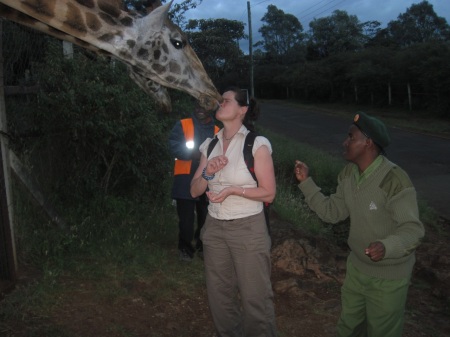 …the Earth is one big party with all kids of life on it, not just plant life and oceans.
…the Earth is one big party with all kids of life on it, not just plant life and oceans.
 We are all a part of it, including man.
We are all a part of it, including man.
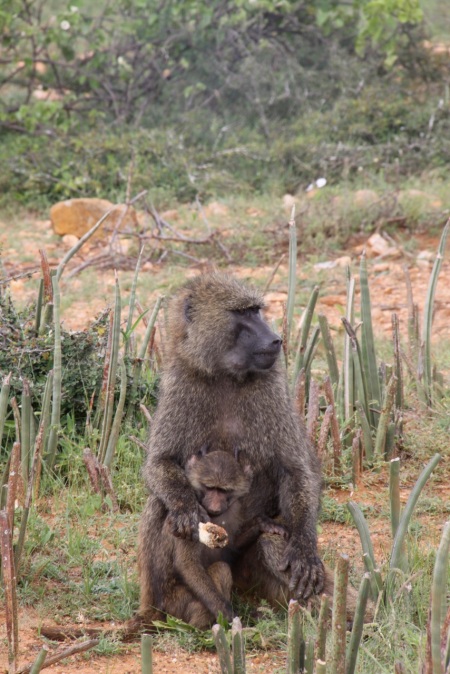 So therefore, the baboon pics. Hoping we can see ourselves in the baboons, and vice versa.
So therefore, the baboon pics. Hoping we can see ourselves in the baboons, and vice versa.
Further Reading and Resources:
Don’t miss our Pinterest board of recommended books about Earth, the Environment, and Human Impact:
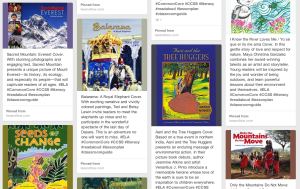
Raising Global Citizens: Jan Reynolds Author Study
Teaching Geo-Literacy Using the Vanishing Cultures series
Where in the World? Using Google Maps to explore the Vanishing Cultures series
Filed under: Curriculum Corner, Holidays Tagged: common core, Earth Day, environment, environmentalism, informational text, nonfiction, photos 

Ecologists and entomologists. Natural history buffs. Bloggers with green thumbs. We're among many WordPress.com users focused on nature and the environment. Today, let's celebrate the work of some of these bloggers.

By: Alice,
on 4/22/2014
Blog:
OUPblog
(
Login to Add to MyJacketFlap)
JacketFlap tags:
OBO,
*Featured,
Science & Medicine,
loch,
Online products,
Oxford Bibliographies,
vale,
environmental science,
Earth & Life Sciences,
Ellen Wohl,
Geosciences,
Earth Day,
geology,
Add a tag
By Ellen Wohl
The 1960s are famous for many reasons: the civil rights movement, the first moon walk, the Cuban missile crisis, rock and roll. The 1960s were also a period when awareness of environmental degradation spread to society at large. Events such as the 1962 publication of Silent Spring, Rachel Carson’s expose of pesticides, the 1969 fire on the Cuyahoga River in Cleveland, Ohio, and the regular occurrence of smog in many of the world’s large cities helped to convince people that pollution and environmental degradation were pervasive and needed to be addressed.
John McConnell proposed a day to honor Earth at a UNESCO conference in 1969, and the first Earth Day was celebrated on 21 March 1970, the spring equinox in the northern hemisphere. This was definitely an idea whose time had come. A month later, another Earth Day was started by US Senator Gaylord Nelson. The second Earth Day took the form of a teach-in first held on 22 April 1970. Earth Day went international in 1990 when US Earth Day coordinator Denis Hayes organized activities in 141 countries. Nearly 200 countries now celebrate Earth Day, and some have expanded the observance to Earth Week. Thinking of this makes me want to paraphrase the standard answer parents give to children when they ask why we have Mother’s Day and Father’s Day but no children’s day: Every day is (or should be) Earth Day.
Earth Day has without question helped to increase visibility of environmental issues and promote governmental and citizen responses to these issues. One indication of this response is the increasing breadth and depth of Environmental Science. Environmental science means different things to different people. Some interpret it as the systematic study of the total environment, a broadly interdisciplinary approach that draws on knowledge from diverse disciplines. Others interpret environmental science as a collection of subdisciplines that explicitly focus on the environmental component within their discipline, typically in an attempt to minimize environmental impacts. Environmental architecture, for example, focuses on green building technology using recycled and sustainable building materials and reduced energy use within buildings. Environmental history examines the development of societies within the context of environmental constraints imposed on human actions and human attitudes toward the environment. The commonality among diverse approaches to environmental science is an explicit recognition that individuals and societies exist within an environmental context defined by the weather, topography, soils, water, and plant and animal communities that interact to create an ecosystem.
Environmental degradation was pervasive and obvious during the early observances of Earth Day. Publication of the now-famous Blue Marble photograph of Earth taken during the 1972 Apollo mission created a stunning reminder of the limited area of the universe habitable by life. More than 40 years on, many of the issues that environmental science addresses today are much less obvious, and may therefore be more difficult to bring to public attention. One of my personal reminders of this is Loch Vale, a stunningly beautiful, high-elevation lake in Rocky Mountain National Park.
Visitors to the national park have to work to reach Loch Vale. The trail to the lake winds over 5.7 miles and gains more than a thousand feet in elevation. When you arrive, you feel that you have reached someplace special, a pristine mountain lake far from the noise and crowding of the urban areas at the base of the mountains. Yet, research by many scientists over the past two decades indicates that the soil and waters of the lake ecosystem are becoming acidic, largely as the result of atmospheric nitrate deposition. These nitrates originate from the feedlots and agricultural lands, industries, and tailpipes of the millions of people living at the base of the mountains, who are out of sight at Loch Vale, but not out of reach. Without the dedicated, ongoing efforts of environmental scientists such as Jill Baron of the US Geological Survey, who has led much of the research at Loch Vale, we would never be aware of the invisible but continuing acidification of this ecosystem.
For me, the lessons of Loch Vale are threefold. First, there is more to environmental degradation than meets the eye. Some of the most thorough and persistent changes are largely hidden from casual view. Second, the efforts of environmental scientists are critical to documenting environmental changes. We can only act to mitigate environmental degradation if we are aware of it. And third, we need Earth Day more than ever. Whatever form your observance of this day takes, I hope that it includes the recognition that every day is lived on Earth.
Ellen Wohl is Professor of Geology in the Department of Geosciences at Colorado State University. She is Editor in Chief of Oxford Bibliographies in Environmental Science, Associate Editor of Earth Surface Processes and Landforms, and a Fellow of the American Geophysical Union and the Geological Society of America. She has published several books on rivers and environmental issues, including Virtual Rivers, Disconnected Rivers, A World of Rivers, Island of Grass, Of Rock and Rivers, and Wide Rivers Crossed.
Developed cooperatively with scholars worldwide, Oxford Bibliographies offers exclusive, authoritative research guides. Combining the best features of an annotated bibliography and a high-level encyclopedia, this cutting-edge resource guides researchers to the best available scholarship across a wide variety of subjects.
Subscribe to the OUPblog via email or RSS.
Subscribe to only earth and life sciences articles on the OUPblog via email or RSS.
Image: Students pick up trash along roadside
The post Earth Day, 44 years on appeared first on OUPblog.


By: PennyF,
on 4/22/2014
Blog:
OUPblog
(
Login to Add to MyJacketFlap)
JacketFlap tags:
food security,
Humanities,
*Featured,
Sports & Games,
walton,
walton’s,
angling,
ecotourism,
environmental attitudes,
illegal fishing,
Izaak Walkton League of America,
izaak walton,
marjorie swann,
the compleat angler,
wildlife management,
compleat,
angler,
amwell,
anglers,
izaak,
Books,
Literature,
fishing,
otter,
Earth Day,
environmentalism,
Add a tag
First published by Izaak Walton in 1653, The Compleat Angler remains one of the most original and influential books about the environment ever written in the English language. Walton’s narrative depicts a group of urbanites whose appreciation of the natural world deepens as they go fishing in the countryside north of London. In honor of Earth Day, here are some interesting facts about The Compleat Angler as an environmental text.
By Marjorie Swann
(1) Before The Compleat Angler, fishermen were regarded as loners, but Walton’s book transformed angling into a sociable activity that draws men together through their shared experiences of the natural world.
(2) Walton champions core principles of wildlife management, including closed seasons, size limits, and restrictions on fishing methods.
(3) For Walton, outdoor recreation enhances spirituality:
“So when I would beget content, and increase confidence in the Power, and Wisdom, and Providence of Almighty God, I will walk the Meadows by some gliding stream, and there contemplate the Lillies that take no care, and those very many other various little living creatures, that are not only created but fed (man knows not how) by the goodness of the God of Nature, and therefore trust in him.”
(4) Walton was an early advocate of food security. Without environmental laws to guarantee sustainable food production, Walton argues, fish stocks will drop so precipitously that the population of England “will be forced to eat flesh.”
(5) As Londoners visiting rural Hertfordshire, Walton’s anglers are exemplary ecotourists. They treat the natural environment they visit respectfully and take care to compensate fairly the local inhabitants who provide their food and lodging.

Otter in Southwold, Suffolk, England. By Catherine Trigg (Flickr) via Wikimedia Commons.
(6) Walton censures “conservators of the waters”—officials charged with overseeing rivers and their fisheries—who turn a blind eye to illegal (and environmentally harmful) fishing practices.
(7) Walton’s anglers practice environmental justice by giving financial donations and most of the fish they catch to poor residents of the countryside.
(8) Reading The Compleat Angler can also help us to appreciate how our attitudes toward the environment have changed over time. Walton regarded otters as pests that should be controlled in order to protect fish populations and in The Compleat Angler, Walton’s fishermen join an otter hunt at Amwell Hill in Hertfordshire. Otters became extinct in Hertfordshire in the 1970s, but in the 1990s, the Otter Trust successfully reintroduced otters to the Amwell Nature Reserve. The Herts and Middlesex Wildlife Trust is now working to improve otter habitat in the Amwell Nature Reserve by creating “fish refuges.”
(9) In the 1890s, the Pullman Company created a special railway car for American sportsmen called the “Izaak Walton.” Staffed by both a cook and a waiter, the car could hold twelve passengers and was fitted out with dog kennels, gun racks, an ammunition room, an ice-chest for game, and a wine closet.
(10) Walton’s depiction of a “brotherhood” of environmentally-conscious anglers inspired the creation of the Izaak Walton League of America, a mass-membership conservation organization founded in 1922 that now has more than 43,000 members in the United States and Britain.
Marjorie Swann, Associate Professor of English at Southern Methodist University, is the author of Curiosities and Texts: The Culture of Collecting in Early Modern England. She has edited a new edition of The Compleat Angler by Izaak Walton and Charles Cotton for Oxford World’s Classics and is now writing a book about Walton’s Angler and its post-seventeenth-century afterlives.
Subscribe to the OUPblog via email or RSS.
Subscribe to only literature articles on the OUPblog via email or RSS.
The post The Compleat Earth Day appeared first on OUPblog.


By: Alice,
on 4/22/2014
Blog:
OUPblog
(
Login to Add to MyJacketFlap)
JacketFlap tags:
Books,
History,
America,
Earth Day,
Nixon,
Environmental Protection Agency,
*Featured,
Gaylord Nelson,
Big Business,
Cold War America,
Consumer Resistance in Postwar America,
Greening the Red White and Blue,
The Bomb,
Thomas Jundt,
Add a tag
By Thomas Jundt
On this day forty-four years ago, some 20 million Americans took to the streets, parks, and lecture halls for an event billed as a national environmental teach-in—Earth Day.
When he announced plans for the event, Wisconsin Democratic Senator Gaylord Nelson, a longtime conservationist, hoped it would gather enough attention to pressure his colleagues into passing environmental legislation that he had been struggling to push through Congress. It did. President Nixon and policymakers responded to the growing environmental fervor with some of the most significant environmental laws in the nation’s history. Although Nixon once called environmental issues “just crap,” he was a savvy politician who understood that the public mood required some sort of action.
On 1 January 1970, the National Environmental Policy Act (NEPA) was signed into law. The National Environmental Education Act, which mandated environmental education in public schools, was signed into law in October. By President Nixon’s executive order the Environmental Protection Agency came into being two months later, charged with overseeing the enforcement of federal environmental policies. The Marine Mammal Protection Act followed in 1972.
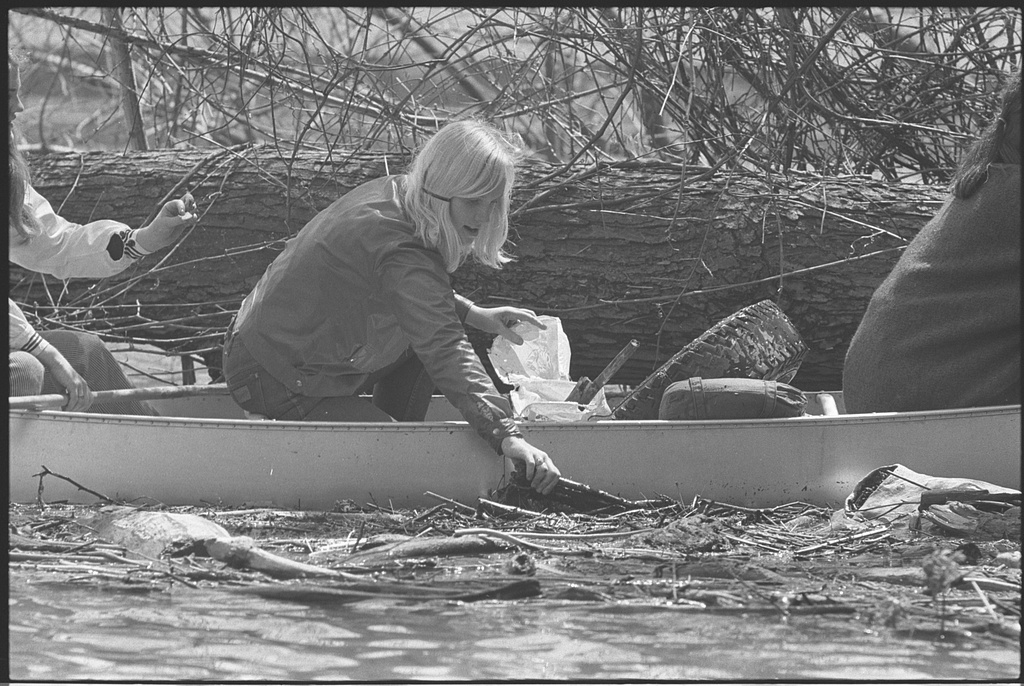
Girl Scout in canoe, picking trash out of the Potomac River during Earth Week. Photo by Thomas J. O’Halloran, 22 April 1970. Courtesy of Library of Congress
Environmentalists had urged such action for decades. The brutal light of atomic bomb flashes revealed a vulnerable planet, and key intellectuals soon recognized other ways that humans might destroy the earth. The head of the New York Zoological Society, Fairfield Osborn, warned of “man’s conflict with nature” in his 1948 bestselling book, Our Plundered Planet. Among the many planetary threats he addressed was the chemical DDT, made public shortly after the war. “The new chemical is deadly on many kinds of insects—no doubt about that,” he conceded. “But what of the ultimate and net result to the life scheme of earth?”
Big business was at the epicenter of this threat. “One of the most ruinous limiting factors is the capitalistic system,” William Vogt emphasized in his own 1948 bestseller, Road to Survival. “Free enterprise—divorced from biophysical understanding and social responsibility… must bear a large share of the responsibility for devastated forests, vanishing wildlife, crippled ranges, a gullied continent, and roaring flood crests.” Desire for stronger federal environmental regulations had been building long before Earth Day, and years before Rachel Carson’s seminal Silent Spring in 1962.
The Earth Day era’s reforms proved inadequate. Rules and regulations that worked well initially were often less effective once corporate lawyers went to work figuring out how they could be exploited, and corporate lobbyists aimed their skills at softening their impact. As Denis Hayes, hired by Senator Nelson to organize Earth Day, said years later, the new laws looked good so long as you ignored things like “graft, corruption, huge campaign contributions, friendships forged on golf links, and all of the other stickiness in the system.”
The real world bore little resemblance to a political-science text. Indeed, in 1972 Nixon moved to undermine his own EPA. The president told his aid, John Ehrlichman, to have the EPA “say a number of things designed to shock the consumer that the cost of the environment will be very high and that the air quality laws are very impractical.” The EPA complied, shaking the public’s confidence enough to reduce or delay a number of antipollution regulations opposed by the automobile industry. “Whether it’s the environment or pollution or Naderism or consumerism,” President Nixon assured a gathering of Ford Motor Company executives, “we are extremely pro-business.”
None of this would have surprised many of the Americans who turned out for Earth Day. As ecologist Kenneth Watt observed in a speech at Swarthmore College in Pennsylvania, “More and more people are giving up on the system. This isn’t just the young people, or the poor, or the black people. I’ve been startled to discover the extent to which white, middle-class, suburban housewives have become so frustrated and are so full of despair about the ability to have any effect on the system that they’ve given up on it.” Mary Humphrey, of the activist group Ecology Action, at an EcoFair near Los Angeles concurred: “I don’t think you’ll find anyone who really thinks the government will do something.”
Perhaps the most telling admission that the political system was not up to the task was made by prominent Senate Democrat and conservationist Edmund Muskie of Maine. “The power of the people is in the cash register,” he proclaimed in an Earth Day speech. He was right.
In a study that asked those who attended Earth Day events in 1970 what actions they would take to help the environment, the plan most frequently cited, by 40% of Earth Day attendees polled, was to change their “consumer behaviors.” In comparison, only about 8% mentioned changes in activities such as joining others to take action.
For critics, this is a troubling example of businesses’ ability to co-opt the ideals of reformers and sell them back to them as organic soy lattes. They charge those who practice personal politics through consumption with avoiding the more difficult work required to organize for traditional politics.
But the retreat to eco-consumerism is understandable. Lacking political solutions, with a two-party system beholden to the very corporations pillaging the planet, citizens concerned about the environment have turned to alternative green consumption. They are not lazy or indifferent, and they are certainly not ignorant. The fact is policy and enforcement favor business at the expense of citizens and the environment.
Organics and other products believed to be environmentally friendly exploded in popularity as producers recognized a ready market in the millions who turned out for Earth Day events across the nation. Today, nearly all consumer products seem to offer a choice of greener alternatives, and for most Americans, consumer choice remains the most popular, if ironic, expression of environmental concern.
During the Cold War Americans heard about citizens in the Soviet Union who coveted Beatles records and blue jeans. Although it might have been a desperate and limited response, we comprehended that type of counterculture consumption as an under-standable reaction to political conditions Soviet citizens felt powerless to change. Green consumption is similar, limited yet understandable. With government in thrall to corporations and chamber of commerce ideologues, as we watch the seas rise, buying a Prius seems like the only game in town.
Thomas Jundt is a visiting assistant professor of history at Brown University, and author of Greening the Red, White, and Blue: The Bomb, Big Business, and Consumer Resistance in Postwar America.
Subscribe to the OUPblog via email or RSS.
Subscribe to only American history articles on the OUPblog via email or RSS.
The post The politics of green shopping appeared first on OUPblog.


By: Alice,
on 4/22/2014
Blog:
OUPblog
(
Login to Add to MyJacketFlap)
JacketFlap tags:
Law,
Journals,
Earth Day,
differentiation,
*Featured,
Earth & Life Sciences,
1990 London Amendments,
1997 Kyoto Protocol,
differentiated responsibility,
Duncan French,
environmental law,
Global responsibility,
international community,
international environmental policy,
Lavanya Rajamani,
Montreal Ozone Protocol,
multilateral environmental agreements,
differential,
rajamani,
lavanya,
Add a tag
By Duncan French and Lavanya Rajamani
As we celebrate Earth Day this year, it is timely to reflect on the international community’s commitment to halting serious environmental harm. The idea that all States have a ‘common interest’ in promoting global environmental responsibility — as evidenced most clearly through their active participation in multilateral environmental agreements — has been a cornerstone of international environmental policy for the last few decades. At the heart of this responsibility is the recognition that sovereign self-interest is enhanced, rather than compromised, through collective responses to matters of global concern. And that universal participation of diverse states in pursuit of common objectives is best secured through differential treatment of states tailored to their responsibilities and capabilities.
But this ideal of responsibility — common but differentiated responsibility — is facing serious challenge. In particular, the increasing questioning of differential treatment as a valuable tool in achieving common objectives has highlighted — if nothing else — a breakdown of previous certainties, however fragile the consensus ultimately was.
Since the 1990 London Amendments to the 1987 Montreal Ozone Protocol, differentiation in commitments and obligations of financial and technological support towards developing countries has characterised, and partially defined, international environmental law. Even among multilateral environmental agreements, the climate change regime is distinctive for the nature and extent of differential treatment it contains in favour of developing countries. The extent of this differential treatment, however, has proven deeply contentious over the years.

Indeed, the 1997 Kyoto Protocol, while representing the high-water mark of differential treatment in international environmental law, is set, to come to an end in 2020. This is partly due to the deep divisions concerning the differential treatment it contains. The latest round of negotiations, under the auspices of the Ad Hoc Group on the Durban Platform (ADP) and which are to conclude in 2015, has been mandated to produce an outcome that is ‘applicable to all’. Although, ‘applicable to all’ implies universality rather than uniformity of application, the use of the term, given the political context of the negotiations, is suggestive of a shift towards greater symmetry and more nuanced differentiation between Parties. The battle over differentiation — the existence, nature and extent of it — is raging in the ongoing climate negotiations, and will no doubt prove to be one of the final issues to be resolved in Paris, 2015.
It could of course be argued that such a shift in the climate regime is but a function of larger geo-political shifts that have occurred in international relations in the past two decades; differentiation as it was originally conceived being an artifact of the period in which it was negotiated. Traditional North-South dichotomies have since disintegrated in the face of economic growth in some developing countries and the shrinking of some first world economies. Such differential treatment in favour of developing countries, especially those that are today in the middle income or higher income brackets, is an anachronism, and thus the move towards greater symmetry, it might be argued, is both natural and politically necessary. Moreover, some developed countries have become disenchanted with differentiation over time, particularly when it is rigidly structured and increasingly viewed as artificial, particularly since the global economic collapse of 2007 and the challenges faced by many ‘developed’ economies.
Whether this move in international environmental law towards greater symmetry and more nuanced differentiation in obligations for Parties, albeit with greater deference to national circumstances, is likely to either result in a more efficient approach, which in turn will promote more ambitious legal outcomes or be sufficient to appease the majority of the global South remains uncertain. Undoubtedly there appears to be a systematic dismantling of a pervasive architecture of differentiation that had assumed a stronghold in international environmental law in the past three decades.
Does this matter; should not international environmental law reflect changing political and economic realities? Should not a regime be negotiated in a manner that seeks to include as many countries as possible? And where a regime such as Kyoto has become so contested, is it not better to seek an alternative that more States can endorse?
While these are valid arguments, they do not account for the fact that differentiation was not adopted merely to improve treaty compliance or prevent a zero-sum outcome in participation. Differentiation reflected a broader ambition; that environmental obligations should be fair and equitable as well as effective. That the international community should not be allowed to neglect historic injustices, enduring differences and considerable disparities in wealth when responding to the environmental challenges. Of course, differentiation can be achieved in many different ways and with greater or more limited financial and technological assistance attached thereto. But the bedrock of differentiation — and even stringent versions of it — had seemingly been accepted. Should this now be disregarded?
There are perhaps equally valid perspectives on this matter that transcend both politics and law. But some queries do arise in this context. If the international community is a community of law, bound within a legal framework, should such a framework to be with or without a moral core? And if the former, what role does equity play and what weight should be placed on it as a characteristic of any legal system? The parties to the climate regime might be right to reconsider their approach to differentiation; but in doing so, equity must still be a valid consideration.
Duncan French is Professor of International Law and Head of the University of Lincoln Law School, UK. He was previously co-rapporteur of the International Law Association’s Committee of International Law on Sustainable Development and is presently Chair of its Study Group on Due Diligence in International Law. Lavanya Rajamani is a Professor at the Centre for Policy Research, New Delhi. She writes, teaches and consults on international environmental law, in particular international climate change law. Her current work is in the field of treaty law (negotiation, design, architecture and interpretation), legal principles and models of differentiation in international agreements.
In recognition of Earth Day this year, we have looked across Law, History, Economics, Literature, Life Science, and Social Sciences to identify key articles in environmental studies, all made freely available.
The Journal of Environmental Law has established an international reputation as a lively and authoritative source of informed analysis for all those active in examining evolving legal responses to environmental problems in national and international jurisdictions.
Oxford University Press is a leading publisher in international law, including the Max Planck Encyclopedia of Public International Law, latest titles from thought leaders in the field, and a wide range of law journals and online products. We publish original works across key areas of study, from humanitarian to international economic to environmental law, developing outstanding resources to support students, scholars, and practitioners worldwide. For the latest news, commentary, and insights follow the International Law team on Twitter @OUPIntLaw.
Subscribe to the OUPblog via email or RSS.
Subscribe to only law articles on the OUPblog via email or RSS.
Image credit: Wild Nature via iStockphoto
The post Global responsibility, differentiation, and an environmental rule of law? appeared first on OUPblog.

By:
Bianca Schulze,
on 4/22/2014
Blog:
The Children's Book Review
(
Login to Add to MyJacketFlap)
JacketFlap tags:
Environment & Ecology,
Books About Plants,
Books About Seeds,
Cindy Jenson-Elliott,
John Hutton,
Ages 0-3,
Ages 4-8,
Picture Books,
Book Lists,
Current Affairs,
Gardening,
featured,
Board Books,
Water,
Melissa Stewart,
Earth Day,
Picture Books For Children,
Lorena Siminovich,
Add a tag
I just love that Earth Day is in spring! It makes perfect sense to capture everyone's attention when they are ready to get back into the great outdoors after winter. Below you'll discover just a couple of the books that have caught my attention because of their appreciation of gardens, plants, and even weeds.
Another special event for Earth Day: The
Kindle and
Nook eBook editions of
Saving the Planet & Stuff are on sale this week for $.99. Kobo's not on sale simply because I couldn't work out how to change the price on the website. If that's a problem for anyone, let me know, and we'll try again.
On sale, all week.
And, remember, you can sign up for a chance to win a
free copy of the eBook for Kindle, Nook, or Kobo through tomorrow, which is Earth Day.

By: En-Szu,
on 4/17/2014
Blog:
Ink Splot 26
(
Login to Add to MyJacketFlap)
JacketFlap tags:
Celebrities,
Earth day,
caroline sunshine,
Kid Power,
ross lynch,
garrett clayton,
jaylen barron,
katherine mcnamara,
kelli berglund,
mollee gray,
olivia holt,
stefanie scott,
Add a tag

How celebrities observe Earth DayEarth Day is on its way! Are you ready? What are YOU doing for Earth Day on April 22? We asked Disney stars like Ross Lynch, Olivia Holt, and a bunch of others what they did last Earth Day (and every day) to stay green. You might be inspired!
ROSS LYNCHAUSTIN & ALLYTEEN BEACH MOVIEMAIA MITCHELLBLAKE MICHAELDOG WITH A BLOGCHLOE AND HALLE BAILEYCAMERON BOYCEJESSIECALUM WORTHYKICKIN’ ITA.N.T. FARMLAB RATSGOOD LUCK CHARLIESHAKE IT UPlove our planet EVERY DAY!
 — En-Szu, STACKS Staffer
— En-Szu, STACKS Staffer
 As I announced earlier this month, I'll be offering a free copy of the eBook edition of Saving the Planet & Stuff for Earth Day, which is next Tuesday, April 22. How do you get a chance to win? Leave a comment on any of my blog posts today through next Tuesday. We'll compile all the names and Computer Guy will use a program he created to randomly select a winner. You're welcome to comment as many days as you like, but we're only going to be counting you once.
As I announced earlier this month, I'll be offering a free copy of the eBook edition of Saving the Planet & Stuff for Earth Day, which is next Tuesday, April 22. How do you get a chance to win? Leave a comment on any of my blog posts today through next Tuesday. We'll compile all the names and Computer Guy will use a program he created to randomly select a winner. You're welcome to comment as many days as you like, but we're only going to be counting you once.
The winner will be announced and notified next Wednesday, April 23. That just happens to be World Book Night, so we'll be celebrating two events at once.
Saving the Planet is available for Kindle, Nook, and Kobo.
"Sixteen-year-old Michael agrees to intern for an environmental magazine, The Earth’s Wife, and finds himself in over his head in politics—of both the environmental and the office kind. This eco-comedy contrasts the radical idealism of the 1960s with twenty-first-century “me-ism.”" That's how Saving the Planet is described on a list of science-themed books at the ALA website.
Wondering why I'm asking for comments instead of including one of those Rafflecopter things? Well, I rarely do giveaways here, so I decided that making the effort to learn how to use Rafflecopter wasn't a good use of my time. Besides, am I the only person who finds them less than attractive?
Let the comments begin.
Maple
By Lori Nichols
Recently I was coming out of a local breakfast gathering place in our small town. It happens to be next to the Historical Society’s building and as I put my hand on the door handle of the car, I glanced down at a brass plaque in the grass at my feet. It jogged my memory to something I had intended to do, but had forgotten; and that was, to plant a tree.
The town has a program to honor someone with the planting of a new tree. For a donation, the tree is planted along with a brass plaque at its base, inscribed with the name and details of the life of the honoree. I meant to do it for my parents. Sort of says, “I was here” and someone recognized that fact. It’s a look backward at a life, as compared with the look forward method celebrated in a picture book that BEGINS with a planting.
Meet Maple. Even BEFORE her appearance, her parents plant a tiny maple tree in her honor. With the planting of that tree variety, comes the perfect name for the soon-to-be-born infant dovetailing rather perfectly with the tree planted – Maple!
Trees symbolize so many things to me, but chief among them are change and growth. And so it is with young Maple. She grows AND changes side by side with her namesake. I love the sense of camaraderie and acceptance that Ms. Nichols builds between the arboreal maple and the human one. If Maple is having a bad day, she visits her leafy counterpart. She sings to it, sways for it and even pretends to BE it. Sweet!
The maple’s leaves provide shade and a place for dreaming amid its branches, but as the seasonal changes inevitably occur and colder weather ensues, the branches are blown BARE! What’s the young Maple to do for her namesake? Why enfold it with her jacket, of course. It is absolutely something a child would do. Instinctively, they seem to want heal the hurting and protect the defenseless. But as we grow older, it sometimes seems a struggle to stay in touch with that basic instinct that we had as children. Thanks for the gentle reminder, Ms. Nichols!
Through a winter that sees new friendships born of snow, via the making of a snowman, Maple finds THAT friendship literally disappears with the appearance of warmer weather. But no matter, Maple and her tree are a forever friendship.
Remember what I said earlier about trees symbolizing growth AND change? What is young Maple to think when she sees a NEW tree planted by her parents? Yup, she is soon to be the BIG SISTER! And Maple is nothing if not adaptable to new situations, sharing HER hat and gloves if the new sibling seems cold, and introducing HER playthings to the baby for amusement. But even young Maple discovers babies can have their fussy times when you wonder WHAT next to try to pacify.
Maple remembers what and who soothed HER, and if past can sometimes provide prologue, then the solution is a simple one; the leafy shade of her tree and the dancing shadows that provide diversion is a nearby solution to this age-old problem. And so the theme of this picture book of nature as friend is both soothing and satisfying.
And lest you think ANOTHER maple was planted for the new arrival to the family, you need not be surprised as Ms. Nichols is wise enough to know that just as no two trees are EXACTLY the same, no two children are EITHER! The new baby’s name and the tree planted in honor of her coming are both named WILLOW!
Lori Nichols has written a book taking the themes of siblings, growth and change and woven them all into a simple tale with a symbolically strong message for parents and young readers. Her art is perfectly matched to the story with Maple’s soft blue shirt, tan pants and standout red maryjanes painting a picture of a charming child going through every day events that may SEEM every day, but actually mark milestones of growth in her life as reflected in nature, not merely numerically, but emotionally.
And, oh yes, before I forget, I have TWO trees to plant, mom and dad!
 Abayomi: The Brazilian Puma, The True Story of an Orphaned Cub is a second picture book from the team, author Darcy Pattison and illustrator Kitty Harvill. (The first was Wisdom: The Midway Albatross.) In Abayomi, Pattison explores what happens when civilization takes over wildlife’s home, and a mother puma is hungry and desperate to feed her cubs. She goes to a farmer’s chickens, which, of course, does not make the farmer happy. In this true story, the mother puma is killed accidentally during a struggle, leaving her cubs. One cub is rescued, Abayomi, and scientists are trying to nurse it back to health, without touching or taming it, so they can return him back to the wild. The paintings by Kitty Harvill are beautiful and add to this touching story, which doesn’t actually have an ending yet, because Abayomi is not ready to go back to the wild as of the writing. This story may be heartbreaking for younger children; heck–it’s heartbreaking for me. But it’s important for children to understand how our growth and civilization affect wild animals. Pattison and Harvill treat the subject with gentleness–there’s no preaching here!
Abayomi: The Brazilian Puma, The True Story of an Orphaned Cub is a second picture book from the team, author Darcy Pattison and illustrator Kitty Harvill. (The first was Wisdom: The Midway Albatross.) In Abayomi, Pattison explores what happens when civilization takes over wildlife’s home, and a mother puma is hungry and desperate to feed her cubs. She goes to a farmer’s chickens, which, of course, does not make the farmer happy. In this true story, the mother puma is killed accidentally during a struggle, leaving her cubs. One cub is rescued, Abayomi, and scientists are trying to nurse it back to health, without touching or taming it, so they can return him back to the wild. The paintings by Kitty Harvill are beautiful and add to this touching story, which doesn’t actually have an ending yet, because Abayomi is not ready to go back to the wild as of the writing. This story may be heartbreaking for younger children; heck–it’s heartbreaking for me. But it’s important for children to understand how our growth and civilization affect wild animals. Pattison and Harvill treat the subject with gentleness–there’s no preaching here!
Pattison also includes some wonderful resources in the back of the book to find out more about this subject and how scientists are trying to help wild animals.
 If you are using this book in the classroom, you could do a KWL chart–what do kids know about pumas before they start reading the book? Then ask them what do they wonder. Finally after reading this, what have they learned?
If you are using this book in the classroom, you could do a KWL chart–what do kids know about pumas before they start reading the book? Then ask them what do they wonder. Finally after reading this, what have they learned?
Students may also feel motivated to brainstorm ways to help wild animals in their own neighborhoods or to visit some of the resources listed in the back of the book!
Great news! I have a copy of the book to giveaway! Use the Rafflecopter form below to enter.
a Rafflecopter giveaway
 Reaper: YA urban fantasy written by St. Louis area author, L.S. Murphy, is the story of sixteen year old Quincy Amarante who will become the fifth grim reaper. Quincy is concerned about one thing before Death enters into her life–being popular and going out with a gorgeous guy. But Death won’t leave her alone and neither does her childhood best friend, Ben–whom all readers will be swooning for by the end of the book. Here’s what I think: I really enjoyed this book from the beginning until the end–it’s one that I found myself anxious to read and getting in the way of the things that I should have been doing, such as work. I know Quin is self-centered at the beginning and mostly concerned with being popular. But I liked her–she had some endearing qualities and was pretty funny actually. I loved the love triangle, the grim reaper aspect, the main character learning about what is actually important in life, and the ending. WOW! no spoilers here, but I was not expecting that ending, and I love it! I would read another YA by LS Murphy in a heartbeat.
Reaper: YA urban fantasy written by St. Louis area author, L.S. Murphy, is the story of sixteen year old Quincy Amarante who will become the fifth grim reaper. Quincy is concerned about one thing before Death enters into her life–being popular and going out with a gorgeous guy. But Death won’t leave her alone and neither does her childhood best friend, Ben–whom all readers will be swooning for by the end of the book. Here’s what I think: I really enjoyed this book from the beginning until the end–it’s one that I found myself anxious to read and getting in the way of the things that I should have been doing, such as work. I know Quin is self-centered at the beginning and mostly concerned with being popular. But I liked her–she had some endearing qualities and was pretty funny actually. I loved the love triangle, the grim reaper aspect, the main character learning about what is actually important in life, and the ending. WOW! no spoilers here, but I was not expecting that ending, and I love it! I would read another YA by LS Murphy in a heartbeat. 
 Five Famous Mice Meet Winston Churchill: This is a picture book by Jean Davies Okimoto and illustrated by Jeremiah Trammell. It’s a sequel to Winston of Churchill. In this book, five mice go on a quest across Canada to let people know about climate change and how it affects everyone. Here’s what I think: The illustrations in this book are great, and the mice are cute. I like how determined the mice are to get noticed, and the ends they go to–to see the polar bears–to have their voices heard. I think this is better suited for K-2. My 3-year-old loved the mice but had a little trouble understanding why people weren’t listening to them and why they had to go to the polar bears. If I taught K-2, I would definitely use this in my classroom for Earth Day.
Five Famous Mice Meet Winston Churchill: This is a picture book by Jean Davies Okimoto and illustrated by Jeremiah Trammell. It’s a sequel to Winston of Churchill. In this book, five mice go on a quest across Canada to let people know about climate change and how it affects everyone. Here’s what I think: The illustrations in this book are great, and the mice are cute. I like how determined the mice are to get noticed, and the ends they go to–to see the polar bears–to have their voices heard. I think this is better suited for K-2. My 3-year-old loved the mice but had a little trouble understanding why people weren’t listening to them and why they had to go to the polar bears. If I taught K-2, I would definitely use this in my classroom for Earth Day.
 Time and Forever: This is Susan B. James’s first romance novel, and it is great. It’s a time travel romance, full of twists and turns. I wrote an entire review for it for The News-Gazette. You can find that here at this link.
Time and Forever: This is Susan B. James’s first romance novel, and it is great. It’s a time travel romance, full of twists and turns. I wrote an entire review for it for The News-Gazette. You can find that here at this link.
 Excelsior: This is a new YA book by George Sirois, who is published by the same publisher as me (Rocking Horse Publishing). In George’s book, high school senior Matthew Peters, Excelsior – savior of faraway planet Denab IV – is becoming an Internet sensation as the main character of a popular online comic strip. But before Matthew can enjoy his burgeoning success, a beautiful older woman arrives at his school and tells him that not only is she from the planet Denab IV, but that Excelsior’s lifeforce lives within him. Here’s what I think: I love books that start in the real world and then go into the fantasy world–and Excelsior delivers on this promise. I also love that Matthew is an everyday hero who turns into the best hero ever!
Excelsior: This is a new YA book by George Sirois, who is published by the same publisher as me (Rocking Horse Publishing). In George’s book, high school senior Matthew Peters, Excelsior – savior of faraway planet Denab IV – is becoming an Internet sensation as the main character of a popular online comic strip. But before Matthew can enjoy his burgeoning success, a beautiful older woman arrives at his school and tells him that not only is she from the planet Denab IV, but that Excelsior’s lifeforce lives within him. Here’s what I think: I love books that start in the real world and then go into the fantasy world–and Excelsior delivers on this promise. I also love that Matthew is an everyday hero who turns into the best hero ever!  I did feel a little sorry for him that the comics he created were actually memories—but you’ll have to read the book to figure out how. I also like that the author did not steer away from modern technology in a fantasy book. Since he sets it in the real world in the beginning and teens are into technology, it was a must he include it and he did not disappoint. (Plus of course, new gadgets were created!) FINALLY, I liked that the adult in Matthew’s life also had to get involved and didn’t just disappear. I think there really are some teenagers who don’t mind an adult or two around every once in a while. . .I’m excited that the author is planning a series.
I did feel a little sorry for him that the comics he created were actually memories—but you’ll have to read the book to figure out how. I also like that the author did not steer away from modern technology in a fantasy book. Since he sets it in the real world in the beginning and teens are into technology, it was a must he include it and he did not disappoint. (Plus of course, new gadgets were created!) FINALLY, I liked that the adult in Matthew’s life also had to get involved and didn’t just disappear. I think there really are some teenagers who don’t mind an adult or two around every once in a while. . .I’m excited that the author is planning a series.
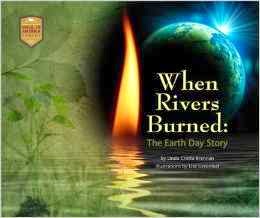 I'm restarting the Environmental Book Club this Earth Day month with When Rivers Burned: The Earth Day Story by Linda Crotta Brennan. This is a lovely book with all kinds of illustrations--photographs, drawings, charts, and text boxes. I feel a little superficial talking first thing about how the book looks, but appearances make a book easier to read, particularly a nonfiction book. When Rivers Burned was also brought out by a smaller publisher, and its appearance is an example of how nice a product they can turn out.
I'm restarting the Environmental Book Club this Earth Day month with When Rivers Burned: The Earth Day Story by Linda Crotta Brennan. This is a lovely book with all kinds of illustrations--photographs, drawings, charts, and text boxes. I feel a little superficial talking first thing about how the book looks, but appearances make a book easier to read, particularly a nonfiction book. When Rivers Burned was also brought out by a smaller publisher, and its appearance is an example of how nice a product they can turn out.
Crotta Brennan does a good job here laying out her material as a narrative. She begins with the pre-Earth Day problems that led to the activism that led to the political action that led to Earth Day. It's not just an environmental book, it's a good beginner nonfiction book. I can see this book being recommended to upper elementary students so they can learn what nonfiction should be and how they should read it.
Only one quibble here--No footnotes or endnotes or bibliography. However, over the last ten years or so I've been seeing nonfiction without footnotes. So there may be something going on in nonfiction publishing that I'm just not aware of.
Transparency issue: I do know Linda Crotta Brennan in a say-hello-at-a-conference sort of way. I got this book through the library, not through Linda or her publisher.
 As I mentioned yesterday, I'll be observing Earth Day all month in an irregular sort of way. I'll be bringing the Environmental Book Club back to life, putting the Kindle edition of Saving the Planet & Stuff on sale at a reduced price the week of April 20 through 26, and offering a free copy to a lucky commenter on Earth Day, itself, April 22.
As I mentioned yesterday, I'll be observing Earth Day all month in an irregular sort of way. I'll be bringing the Environmental Book Club back to life, putting the Kindle edition of Saving the Planet & Stuff on sale at a reduced price the week of April 20 through 26, and offering a free copy to a lucky commenter on Earth Day, itself, April 22.
Speaking of Saving the Planet & Stuff and all things environmental, I learned earlier this year that the original edition of that book was included on an ALA list of Science-Themed Novels. It's classified under Landforms and the Environment.
Landforms and the Environment. Does this mean I could be on the Big Bang Theory?
By: C. C. Gevry,
on 4/21/2013
Blog:
The Children's and Teens' Book Connection
(
Login to Add to MyJacketFlap)
JacketFlap tags:
virtual book tour,
Guardian Angel Publishing,
Contemporary fiction,
Earth Day,
environmentalism,
Nancy Stewart,
books for young readers,
Environmental issues,
Academic Wings,
The Children's and Teens Book Connection,
Bella Saves the Beach,
children's books,
Bella and Britt series,
Children's picture books,
books that teach a lesson,
books that teach children a lesson,
children's books that teach a lesson,
Animal lovers books,
Add a tag
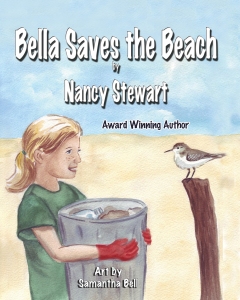
Bella and Britt are worried about all the trash appearing on their beautiful beach. But what can they do? Britt is leaving on vacation, and Bella can’t solve the problem alone. Without adults to lend a hand, can they possibly save their beach?
Purchase from:
NANCYSTEWARTBOOKS.COM
GUARDIAN ANGEL PUBLISHING
AMAZON
BARNES AND NOBLE
Earth Day—Every Human’s Responsibility
by Nancy Stewart
Ah, yes, Earth Day. We think about it once a year. Celebrate it? Let’s not go overboard. After all, aren’t the governments of the world doing something about it—whatever it is?
Earth Day, founded by Senator Gaylord Nelson, was first organized in 1970 to promote ecology and respect for life on the plane. It has come a long way from then with one hundred forty countries around the globe participating this year. And counting. Earth Day, very much like Earth Hour, has taken on a life of its own.
Here is one of the most outstanding projects we should be talking about for Earth Day, 2013. It is The Canopy Project. Over the past three years, this project has planted over 1.5 million trees in 18 countries. In the US, projects to restore urban canopies have been completed in many large cities. In Haiti alone, where earthquakes caused landslides on deforested hillsides, leading to horrific devastation, Earth Day Network planted 500,000 trees. In three high-poverty districts in central Uganda, they planted 350,000 trees to provide local farmers with food, fuel, fencing, and soil stability.
Climate change can seem like a remote problem for our leaders, but the fact is that it’s already impacting real people, animals, and beloved places. These Faces of Climate Change are multiplying every day. What can be done about it? Each of us, individually, can make a difference. When we all do our share, the entire world can begin to heal itself.
I’ve pledged to not use plastic bags, to using cold water in the washing machine and to using earth friendly cleaning products. We’ve changed all light bulbs to save electricity, and they are turned off when leaving a room. I remind students when doing a book signing that turning off a light helps save a polar bear!
But it’s more than these things, isn’t it? Helping save our planet is really a state of mind. It’s being in the flow of good ecology every day, even every minute. And soon, it’s a way of life. Living this state of mind will help save all our lives and the lives of those to come, our children and our grandchildren. What better ongoing gift can we give to anyone than a sustainable, green and whole planet? Oh, and it’s not, of course, just April 22. It’s every day, every minute for the rest of our lives.
 Nancy is the bestselling and award winning author of the four Bella and Britt Series books for children: One Pelican at a Time (eighteen weeks on Amazon Bestselling List), Sea Turtle Summer, (which won the Children’s Literary Classic Gold Award), Bella Saves the Beach (which won the Gold) and Mystery at Manatee Key. The authorized biography, Katrina and Winter: Partners in Courage, is the story of Katrina Simpkins and Winter, the dolphin. One Pelican at a Time and Nancy were featured in the PBS Tampa special, GulfWatch. All are published by Guardian Angel Publishing.
Nancy is the bestselling and award winning author of the four Bella and Britt Series books for children: One Pelican at a Time (eighteen weeks on Amazon Bestselling List), Sea Turtle Summer, (which won the Children’s Literary Classic Gold Award), Bella Saves the Beach (which won the Gold) and Mystery at Manatee Key. The authorized biography, Katrina and Winter: Partners in Courage, is the story of Katrina Simpkins and Winter, the dolphin. One Pelican at a Time and Nancy were featured in the PBS Tampa special, GulfWatch. All are published by Guardian Angel Publishing.
Nancy is a frequent speaker and presenter at writer’s conferences throughout the United States. She conducts workshops and seminars and speaks to school children on writing and helping save their planet. A blogger with a worldwide audience, she writes of all things pertaining to children’s literature.
Nancy’s travels take her extensively throughout the world, most particularly Africa. She is US chair of a charity in Lamu, Kenya, that places girls in intermediate schools to allow them to further their education. She and her husband live in Tampa and St. Louis.
Visit her online at www.nancystewartbooks.com and her blog at http://www.nancystewartbooks.blogspot.com
Bella Saves the Beach Tour Schedule
Monday, April 22nd
Guest post at The Children’s and Teens’ Book Connection
Tuesday, April 23rd
Book trailer feature at If Books Could Talk
Wednesday, April 24th
Book review at On Words – Opening Eyes, Opening Hearts
Thursday, April 25th
Book spotlight and giveaway at The Busy Mom’s Daily
Book review at Shannon Hitchcock Pen and Prose
Monday, April 29th
Book review at Hook Kids on Reading
Guest post at The Pen and Ink
Tuesday, April 30th
Guest post at Write What Inspires You
Wednesday, May 1st
Book review at LadyD Books
Thursday, May 2nd
Book review at Kid Lit Reviews
Friday, May 3rd
Guest post at Lori’s Reading Corner
Monday, May 6th
Interview at Tribute Books Reviews and Giveaways
Tuesday, May 7th
Book reviewed at The Picture Book Review
Wednesday, May 8th
Book reviewed at My Devotional Thoughts
Thursday, May 9th
Book review at It’s About Time Mamaw
Friday, May 10th
Book review at The Children’s and Teens’ Book Connection
Monday, May 13th
Book review at 4 the Love of Books
Tuesday, May 14th
Book spotlight at Review from Here
Book review at The Jenny Revolution
Wednesday, May 15th
Guest post at Literarily Speaking
Thursday, May 16th
Book review at Mrs. Mommy Booknerd’s Reviews
Friday, May 17th
Book spotlight at I’m A Reader, Not A Writer
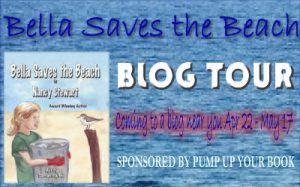


By:
Inderjit Deogun,
on 4/19/2013
Blog:
The Pen Stroke | A Publishing Blog
(
Login to Add to MyJacketFlap)
JacketFlap tags:
The Moment,
50 Book Pledge,
Jess Walter,
Morning in the Burned House,
We Live in Water,
Poetry,
Earth Day,
National Poetry Month,
Margaret Atwood,
Add a tag
| 50 Book Pledge | Book #22: We Live in Water by Jess Walter |
In honour of National Poetry Month and Earth Day, on Monday, April 22, I present “The Moment” from Morning in the Burned House by Margaret Atwood.
The moment when, after many years
of hard work and a long voyage
you stand in the centre of your room,
house, half-acre, square mile, island, country,
knowing at last how you got there,
and say, I own this,
is the same moment when the trees unloose
their soft arms from around you,
the birds take back their language,
the cliffs fissure and collapse,
the air moves back from you like a wave
and you can’t breathe.
No, they whisper. You own nothing.
You were a visitor, time after time
climbing the hill, planting the flag, proclaiming.
We never belonged to you.
You never found us.
It was always the other way round.


Title: Sublime PlanetAuthors: Carolyn Howard-Johnson and Magdalena Ball
Photos: Ann Howley
ISBN: 978-1482054705
Reviewed by Karen Cioffi
Gearing up for Earth Day, Carolyn Howard-Johnson and Magdalena Ball are releasing a brand new collection of poems titled Sublime Planet. The collection features relevant poems by Carolyn and Magdalena that demonstrate the interconnections of the world around us, including life, family, and love, along with the growing concern for the earth’s preservation.
This is a beautifully written collection that allows the reader to pause and take note of the world around her.
One of my favorite poems in the collection is “The Giraffe:”
A tongue generousas my head he reachesfor me, barriers no matchfor his long neck, sniffsmy hair, kisses my face.He unawarehe is endangered.I unaware he mightbe dangerous.This poem is a powerful, yet simple tribute to a majestic creature that is now an endangered species. Can you imagine a planet without the giraffe?
Another poem in the collection that struck me is “Tipping Point” by Magdalena Ball: “
[. . .] you eat and eat through four billion years of evolution now held loosely by one thread. [. . .] The future waits impatiently your decision.”Again, powerful, and revealing.
Sublime Planet offers moving insight into the world around us and into a world that is in need of attention, and it certainly honors Earth Day.
I highly recommend it.For those who aren’t aware of what Earth Day is, Senator Gaylord Nelson created this special day in the spring of 1970. The purpose behind it was to make everyone aware of all the toxins being spewed into the air and dumped in nearby streams or other waterways by manufacturing companies.
At that time, there were no regulatory or legal safety nets to protect our planet, our environment. Senator Nelson took a stand and his cause quickly caught on.
The earth is our planet, our home, our responsibility, and we’re not doing such a good job protecting it.
Sublime Planet will be released before Earth Day (April 22nd). Keep a look out for it and get a copy as soon as it’s available.
The poems "Giraffe" and “Tipping Point” are from
Sublime Planet, a book of poetry in the Celebration Series coauthored by Carolyn Howard-Johnson and Magdalena Ball. It will be released before Earth Day. In the meantime learn more about Carolyn's poetry books (including that Celebration Series!) at
http://howtodoitfrugally.com/poetry_books.htm. And, learn more about Magdalena’s poetry and fiction at
http://magdalenaball.com

Darcy Pattison and Science Specialist, Marilyn Johnson on Earth Day.
CONGRATS to the fabulous 2012
Authors for Earth Day Participants: Steve Swinburne, Dan Gutman, Jennifer Ward, Barb Rosenstock, Barbara Gowan, Conrad Storad, Michelle Worthington, Molly Idle and myself.
To date, the Authors for Earth Day coalition has given voice to young readers across the United States (FL, AZ, NY, PA, NJ, CA, CT, AR, IL & VT) and they even went international this year with an A4ED author visit in Queensland, Australia. In addition to inspiring thousands of students, contributions to conservation have grown to over $15,600! The organizations that benefitted from this year’s school visits were: National Park Foundation, World Wildlife Fund, Humane Society of the United States, Southwest Wildlife, Audubon Arkansas, Australian Koala Foundation, Watershed Nature Center, Phoenix Zoo Conservation Fund, and Kitts Sea Turtle Monitoring Network.
On the A4ED blog, this spring brought several new guest-bloggers—Joan Donaldson, Natasha Wing, Linda Crotta Brennan and Linda Bozzo—who shared personal insight into their writing with some valuable thoughts about living a little “greener.” Readers can enjoy those special written contributions at any time at www.authorsforearthday.org/blog.
SCBWI Summer Conferenc
AuthorsForEarthDay.org will have a table at the SCBWI summer conference, August 3-6. Stop by and talk to them about participating next year.

.jpeg?picon=3306)
By: Zoe,
on 4/29/2012
Blog:
Playing by the book
(
Login to Add to MyJacketFlap)
JacketFlap tags:
Adventure,
Imagination,
Nonfiction Monday,
Earth Day,
Beaches,
Neal Layton,
Nature play,
Slugs and snails,
Fiona Danks,
Jo Schofield,
John Hegley,
Add a tag
Things-I-have-learned-as-a-parent number 359: A walk for the sheer fun of it, in our local park or nature reserve, is never complete without a stick.
The sooner the girls can find one which meets their ideals for the day the happier they are. A big one to lean on, a little one to become a wand, a bendy one to be a flag: a stick is an essential acquisition on any sort of exploration.

Image: Daniel Baker
 And so it was with some eagerness that I accepted The Stick Book by Jo Schofield and Fiona Danks for review. Would the girls and I get new ideas and be inspired in new ways? Would it encourage us out on those days we were suffering from inertia? Would it make me look with refreshed, delighted eyes at the pile of sticks by our back door that grows and grows and normally has me rolling my eyes in slight desperation?
And so it was with some eagerness that I accepted The Stick Book by Jo Schofield and Fiona Danks for review. Would the girls and I get new ideas and be inspired in new ways? Would it encourage us out on those days we were suffering from inertia? Would it make me look with refreshed, delighted eyes at the pile of sticks by our back door that grows and grows and normally has me rolling my eyes in slight desperation?
The Stick Book contains 70 different ideas for using sticks in outdoor play. There are 8 themed chapters, for example one on “Stick games” (including pick up sticks, capture the flag, and tracking with stick), one on “Adventure sticks” (including building dens, swords, catapults and spear throwers) and on on “Watery sticks” (including pooh sticks, making a mini raft and measuring the depth of a stream). Each activity is accompanied by a photograph and tips or brief instructions on the activity in question.
Essentially, this is a craft book, not unlike those you might get from the library packed with Easter crafts or Egyptian crafts. It’s just that this time the unifying theme is outdoor play with sticks. And like many craft books, with the advent of the internet, and great sites like Let the Children Play, the ideas you find within the pages are probably available for free somewhere online, and many of them are so simple (such as playing pooh sticks) that you might wonder if this really is a book worth buying.

It’s definitely worth seeking out. By bringing all the ideas together in one place it IS stimulating. It has motivated the girls and me get our shoes on and go walking and looking for good sticks. M in particular has enjoyed reading the book herself, and choosing an activity she’d like to do. I particularly like the fact that all the people who feature in this book’s photographs are kids. There’s not an adult to be seen in this idyllic, natural landscape full of potential for adventure.
As children increasingly lose contact with outdoor play, and adults become less confident and comfortable with it (after all, isn’t it easier to put on a DVD?), this book will hopefully be a useful reminder of how simple and enjoyable it is to play outdoors. All you need is a stick and a little bit of inspiration.

.
Geez… I remember 1990, when Earth Day was revived to celebrate the 20th anniversary. Now it’s 2012, and environmentalism has become mainstream, with systematic recycling, organic groceries, and greater fuel efficiencies widespread. While it continues to be a topic of discussion politically, most people have gotten the message. (Ironically, the Republican Party tends to promote a different type of “green”, even though much of the environment we enjoy in this country was the result of two Republican presidents: Roosevelt and Nixon.)
Even some comics publishers have gone green, using standards from the Green Press Initiative for graphic novels. (Periodical comics are a bigger problem, as this Comic Foundry article notes.)
So, to celebrate, let’s shine a spotlight on one of most famous, but generally ignored, ecological cartoon characters: Woodsy Owl.
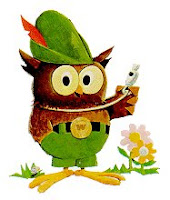 According to Wikipedia, “The original slogan “Give a Hoot Don’t Pollute” and the owl were created by Kimberly Ann Haufrect an eight year old girl in 1968 who won a contest held by the United Way”.
According to Wikipedia, “The original slogan “Give a Hoot Don’t Pollute” and the owl were created by Kimberly Ann Haufrect an eight year old girl in 1968 who won a contest held by the United Way”.
On Earth Day 1970, the National Forest Service (part of the USDA, and the same agency which also employs Smokey Bear) debuted Woodsy. Harold Bell, a former marketer and licensing agent for Disney had launched his own agency in 1957, with clients such as Mister Magoo, Dick Tracy, the Lone Ranger, and Lassie (as well as working with the Forest Service promoting Smokey Bear). It was while working with the “Lassie” television series that he met rangers Chuck Williams and Glenn Kovar and their co-worker Betty Hite, who served as technical consultants on the show (which featured U.S. forest rangers).
The New York Times reported that they “considered a raccoon, a bull elk, a rainbow trout and a ladybug. They chose an owl because owls are supposed to be wise, live in the forest and near cities, and can see pollution from treetops.” The character has become so well known, that his trademark, which was created by the federal government and which is thus in the public domain, is protected by law. (Smokey received similar treatment, in 36 C.F.R. PART 271.)
(I remember Kellogg’s Cocoa Hoots cereal (which also had an educational tint) and the infamous Mr. Owl of Tootsie Pop. Was there an owl zeitgeist in the early 1970s? The world may never know…)
Just like Smokey, Woodsy was marketed extensively in all media. While Woodsy did not have a cartoon show, he did appear in numerous public service announcements broadcast on Saturday mornings in the 70s, and briefly starred in a ten-issue qua
View Next 25 Posts





































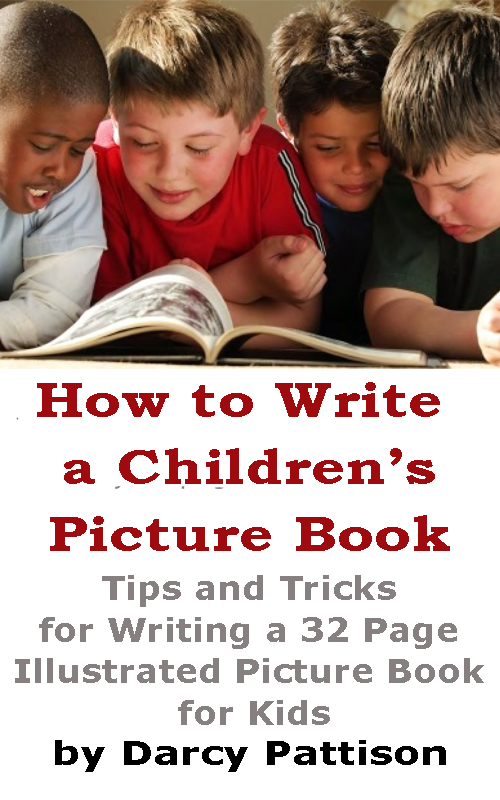





That bunny has been busy lately and so giving. Lovely.
Thanks, Vicki! I know, it must have been the coffee!
Lovely!